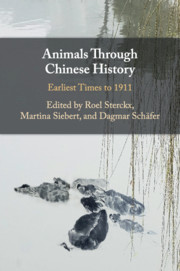Book contents
- Animals through Chinese History
- Animals through Chinese History
- Copyright page
- Contents
- Figures
- Tables
- Contributors
- Acknowledgements
- Chronology of Dynasties
- Knowing Animals in China’s History
- 1 Shang Sacrificial Animals
- 2 Animal to Edible
- 3 Noble Creatures
- 4 Walking by Itself
- 5 Bees in China
- 6 Where Did the Animals Go?
- 7 Animals as Text
- 8 Great Plans
- 9 Animals in Nineteenth-Century Eschatological Discourse
- 10 Reconsidering the Boundaries
- 11 Animals as Wonders
- 12 Reforming the Humble Pig
- Bibliography
- Index
- References
Bibliography
Published online by Cambridge University Press: 08 December 2018
- Animals through Chinese History
- Animals through Chinese History
- Copyright page
- Contents
- Figures
- Tables
- Contributors
- Acknowledgements
- Chronology of Dynasties
- Knowing Animals in China’s History
- 1 Shang Sacrificial Animals
- 2 Animal to Edible
- 3 Noble Creatures
- 4 Walking by Itself
- 5 Bees in China
- 6 Where Did the Animals Go?
- 7 Animals as Text
- 8 Great Plans
- 9 Animals in Nineteenth-Century Eschatological Discourse
- 10 Reconsidering the Boundaries
- 11 Animals as Wonders
- 12 Reforming the Humble Pig
- Bibliography
- Index
- References
- Type
- Chapter
- Information
- Animals through Chinese HistoryEarliest Times to 1911, pp. 244 - 273Publisher: Cambridge University PressPrint publication year: 2018
- Creative Commons
- This content is Open Access and distributed under the terms of the Creative Commons Attribution licence CC-BY-NC-ND 4.0 https://creativecommons.org/cclicenses/

